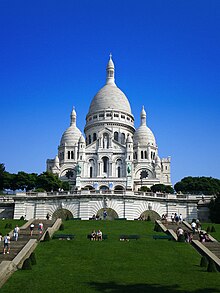Basilique du Sacre-Coeur
| Basilica of the Sacred Heart of Jesus Basilique du Sacré-Cœur (French) |
|
|---|---|

The Basilica of Sacré-Cœur, as seen from the base of the butte Montmartre.
|
|
| Basic information | |
| Location | Paris, France |
| Geographic coordinates | 48°53′12.1″N 2°20′34.8″E / 48.886694°N 2.343000°ECoordinates: 48°53′12.1″N 2°20′34.8″E / 48.886694°N 2.343000°E |
| Affiliation | Roman Catholic |
| Province | Archdiocese of Paris |
| Year consecrated | 1919 |
| Ecclesiastical or organizational status | Minor basilica |
| Website | Basilica of the Sacré Cœur |
| Architectural description | |
| Architect(s) | Paul Abadie |
| Groundbreaking | 1875 |
| Completed | 1914 |
| Specifications | |
| Length | 85 metres (279 ft) |
| Width | 35 metres (115 ft) |
| Height (max) | 83 metres (272 ft) |
| Materials | Travertine stone |
The Basilica of the Sacred Heart of Paris, commonly known as Sacré-Cœur Basilica and often simply Sacré-Cœur (French: Basilique du Sacré-Cœur, pronounced [sakʁe kœʁ]), is a Roman Catholic church and minor basilica, dedicated to the Sacred Heart of Jesus, in Paris, France. A popular landmark, the basilica is located at the summit of the butte Montmartre, the highest point in the city. Sacré-Cœur is a double monument, political and cultural, both a national penance for the defeat of France in the 1870 Franco-Prussian War and the socialist Paris Commune of 1871 crowning its most rebellious neighborhood, and an embodiment of conservative moral order, publicly dedicated to the Sacred Heart of Jesus, which was an increasingly popular vision of a loving and sympathetic Christ.
The Sacré-Cœur Basilica was designed by Paul Abadie. Construction began in 1875 and was finished in 1914. It was consecrated after the end of World War I in 1919.
The inspiration for Sacré Cœur's design originated on September 4, 1870, the day of the proclamation of the Third Republic, with a speech by Bishop Fournier attributing the defeat of French troops during the Franco-Prussian War to a divine punishment after "a century of moral decline" since the French Revolution, in the wake of the division in French society that arose in the decades following that revolution, between devout Catholics and legitimist royalists on one side, and democrats, secularists, socialists and radicals on the other. This schism in the French social order became particularly pronounced after the 1870 withdrawal of the French military garrison protecting the Vatican in Rome to the front of the Franco-Prussian War by Napoleon III, the secular uprising of the Paris Commune of 1870-1871, and the subsequent 1871 defeat of France in the Franco-Prussian War.
...
Wikipedia
